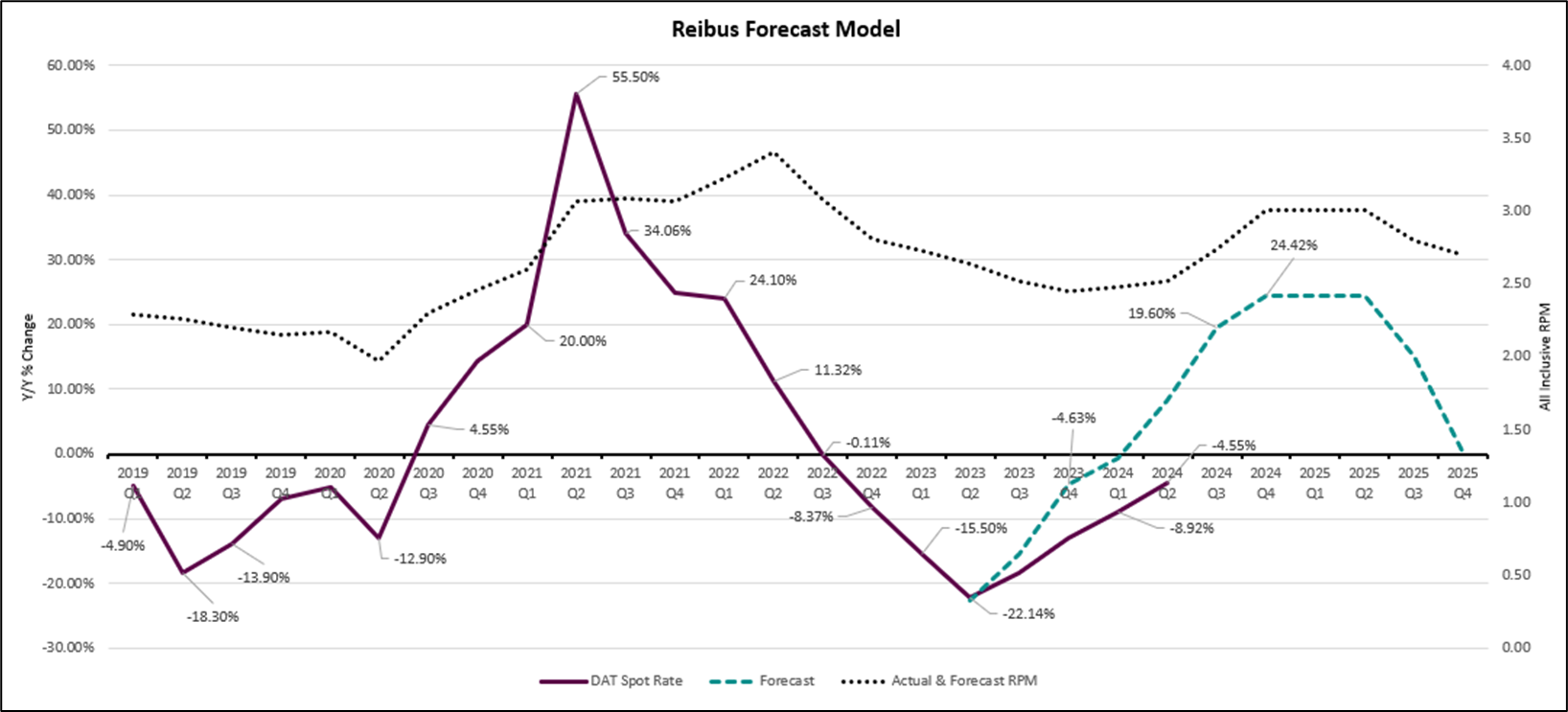Shipping and Logistics

Reibus May logistics market update
Written by Robert Martin
May 17, 2024
Flatbed update
Roughly halfway through Q2, flatbed rates are holding firm, currently showing no change from April to May and a slight increase quarter over quarter (q/q). The increase amounts to +1.6% q/q so there’s nothing to write home about for carriers just yet. It remains to be seen whether the annual CVSA Roadcheck or seasonal demand patterns will be enough to give rates any real lift. No Black Swans thus far in 2024. Our potential accelerators and decelerators remain unchanged.

Dry van update
On the dry van side of the market, rates are also moving sideways. Rates are flat from April to May and down slightly q/q. Dry van rates appear to have found the floor but continue to stay there, bouncing along the bottom with little movement over the past six months. Spot rates have moved within a nine-cent margin for the past 14 months, marking a very calm and somewhat boring market by historical standards.
Active brokerages continues decline
After a stark mean reversion from pandemic-driven highs, rates have remained as stable as they’ve been in the past two decades. Following a significant increase in active brokerages from late 2020 to early 2023, the number of active brokerages is also reverting towards the mean and trending back in line with long-term trends. This adjustment appears healthy as overall supply in the marketplace continues to rationalize.
Except from the April LMI
The Logistics Manager’s Index (LMI) reads in at 52.9 in April 2024. This is down (-5.4) from March’s reading of 58.3, which was the highest rate of growth in 18 months. While this still indicates growth in the logistics industry, this breaks what had been four consecutive months of increasing rates of expansion and is the slowest rate of growth observed so far in 2024. The slowed pace of growth is driven by a significant decrease in the expansion of Inventory Levels (down 12.8-points to 51.0, which is the most marginal level of expansion). This has cascading effects across the supply chain, as lower levels of inventory led to a loosening of both Warehousing (+9.4) and Transportation (+1.8) Capacity, slower expansion for Warehousing Utilization (-8.5), and most importantly, Transportation Prices moving back into contraction at a rate of 44.1. There had been signs that the transportation market was moving back towards equilibrium. However, with the movements in our transportation metrics, Transportation Capacity is now 17.3-points higher than Transportation Prices (61.4 to 44.1) indicating that we are still firmly in a state of freight recession.
Class 8 truck orders
Historically, class 8 truck orders have represented the backbone of the market capacity cycle that drives transportation rates. There have been sporadic order patterns in recent years which have bucked the traditional norm. Over the last few months, we appear to be returning to more normal order patterns, with demand falling off as transportation rates have remained suppressed. Orders for April came in at 14,000 units, representing a 28% m/m decline. We would expect this trend to continue as capacity continues to exit the marketplace and not to reverse itself until we see a rally in spot rates, followed by an eventual rally in contract rates.
Macro economy
When zooming out and looking at the economy as a whole, consumers remain optimistic we could see rate cut by year’s end. For that to happen, inflation will need to show strong indicators of moving towards the Fed’s target. In April, wholesale prices rose 0.5% m/m and came in 2.2% higher on a 12-month basis, the largest gain in a year. Core PPI also rose 0.5% m/m compared to an estimate of 0.2% by Dow Jones economists. Overall, CPI remains stubbornly high, coming in at 3.4% in April on a 12-month basis. While inflation has certainly moderated compared to recent years, it remains well above the Fed’s stated target of 2%.
To see the full report or for further details and inquiries, reach out to Reibus Logistics and the author Robert Martin at robert.martin@reibus.com.

Robert Martin
Read more from Robert MartinLatest in Shipping and Logistics

Trump signs executive order aimed at making US shipbuilding ‘great again’
President Trump on Wednesday signed an executive order meant to breathe new life into American shipbuilding and curb Chinese dominance in the sector.

Great Lakes iron ore trade fell again in March
Recall that shipments also saw a sharp decline in January.

Longshoremen ratify contract with maritime alliance
Nearly 99% of ILA members voted in favor of a new labor deal with the United States Maritime Alliance that covers workers at ports on the Atlantic and Gulf coasts.

Reibus: Flatbed rates up slightly but uncertainty ahead
With construction seasonally soft, the flatbed market remains softer than the other main trailer types.

US-flagged ore shipments on Great Lakes down in 2024
The Lake Carriers’ Association reported a 4.5% y/y decline in December’s ore shipments of 4.6 million short tons.
